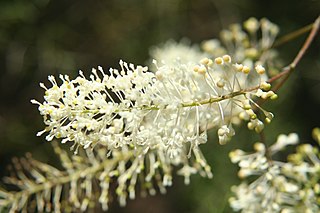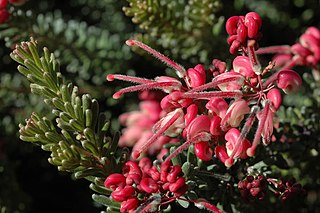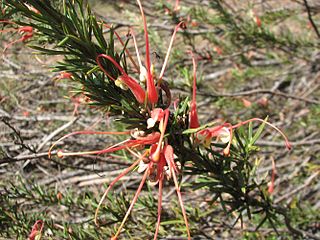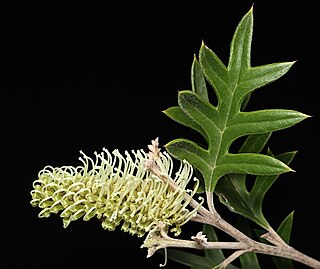
Grevillea leptopoda is a species of flowering plant in the family Proteaceae and is endemic to the south-west of Western Australia. It is a spreading to erect shrub with divided leaves, the lobes further divided, the end lobes linear, and clusters of white to cream-coloured flowers.

Grevillea lanigera, commonly known as woolly grevillea, is a species of flowering plant in the family Proteaceae and is endemic to south-eastern continental Australia. It is a spreading shrub with narrowly oblong to more or less linear leaves and clusters of pink to red, and cream-coloured flowers.

Grevillea paniculata, commonly known as kerosene bush, is a species of flowering plant in the family Proteaceae and is endemic to the south-west of Western Australia. It is a dense shrub with divided leaves, the lobes linear, and more or less spherical clusters of white to cream-coloured flowers.

Grevillea concinna, commonly known as red combs or elegant grevillea, is a species of flowering plant in the family Proteaceae and is endemic to the south-west of Western Australia. It is a spreading to erect shrub with mostly linear to narrow wedge-shaped leaves sometimes with a sharp point on the tip. Flower colour varies with subspecies.

Grevillea rivularis, commonly known as Carrington Falls grevillea, is a species of flowering plant in the family Proteaceae and is endemic to New South Wales. It is a dense, spreading shrub with divided leaves with more or less linear, sharply-pointed lobes, and clusters of cream-coloured flowers that turn pink or grey as they age.

Grevillea tripartita is species of flowering plant in the family Proteaceae and is endemic to the south-west of Western Australia. It is an erect, prickly shrub with divided leaves with 3 lobes, and clusters of red and cream-coloured or reddish-orange and yellow flowers.

Grevillea willisii, commonly known as Omeo grevillea or rock grevillea, is species of flowering plant in the family Proteaceae, and is endemic to the eastern highlands of Victoria, Australia. It is a spreading to erect shrub with pinnatipartite leaves, the end lobes broadly triangular to oblong and sometimes sharply pointed, and dense clusters of greenish-white to fawn-coloured flowers with a white to cream-coloured style.

Grevillea pachylostyla, commonly known as Buchan River grevillea, is a species of flowering plant in the family Proteaceae and is endemic to Victoria in Australia. It is a mounded to almost prostrate shrub with divided leaves, the end lobes triangular, and usually down-curved, more or less toothbrush-like clusters of cream-coloured flowers that turn` pink to red after opening.

Grevillea huegelii, commonly known as comb spider-flower or comb grevillea, is a species of flowering plant in the family Proteaceae and is endemic to southern continental Australia. It is an erect to low-lying shrub with divided leaves with mostly three to eleven sharply-pointed linear lobes, and clusters of red to pink flowers that are silky-hairy on the outside.

Grevillea plurijuga is a species of flowering plant in the family Proteaceae and is endemic to southern Western Australia. It is a prostrate to low-lying or dense mounded to erect shrub with divided leaves with linear lobes and loose clusters of hairy, red or pink flowers.
Grevillea lullfitzii is a species of flowering plant in the family Proteaceae and is endemic to a relatively small area of inland Western Australia. It is a spreading shrub with deeply divided leaves, the lobes linear and sharply-pointed, and clusters of greyish-white and cream flowers with an off-white style.

Grevillea ramosissima, commonly known as fan grevillea, is a species of flowering plant in the family Proteaceae and is endemic to eastern continental Australia. It is a low, spreading shrub with lobed leaves and clusters of cream-coloured to pale yellow flowers.

Grevillea triternata is species of flowering plant in the family Proteaceae and is endemic to New South Wales. It is a dense, compact shrub with divided leaves, the end lobes sharply pointed, linear to narrowly triangular, and cylindrical clusters of white flowers with a cream-coloured to pale yellow style.
Grevillea nematophylla, commonly known as water bush or silver-leaved water bush, is a species of flowering plant in the family Proteaceae and is endemic to Australia. It is shrub or small tree with simple or pinnatisect leaves, the leaves or lobes linear, and branched, cylindrical clusters of cream-coloured flowers.

Grevillea anethifolia, commonly known as spiny cream spider flower, is a species of flowering plant in the family Proteaceae and is endemic to continental Australia. It is an erect shrub with hairy branchlets, lobed leaves, the lobes sharply pointed, and white to pale yellow or cream-coloured flowers.

Grevillea muelleri is a species of flowering plant in the family Proteaceae and is endemic to the a relatively small area of south-western Western Australia. It is a shrub with linear to narrowly oblong, or divided leaves with linear or narrowly egg-shaped lobes, more or less spherical clusters of white to cream-coloured flowers.

Grevillea obliquistigma is a species of flowering plant in the family Proteaceae and is endemic to the south-west of Western Australia. It is a spreading shrub with linear leaves, and conical to cylindrical clusters of creamy-white to yellowish cream-coloured flowers, sometimes tinged with pink.

Grevillea paradoxa, commonly known as the bottlebrush grevillea, is a species of flowering plant in the family Proteaceae and is endemic to the south-west of Western Australia. It is an erect to spreading, prickly shrub with pinnatipartite leaves, the lobes linear, widely spreading and sharply pointed, and with cylindrical clusters of pale to dark pink or cream-coloured flowers with a pinkish-red style.

Grevillea patentiloba is a species of flowering plant in the family Proteaceae and is endemic to the south-west of Western Australia. It is a prostrate to erect, spreading to straggling shrub with divided leaves, and down-turned clusters of red to deep pink and cream-coloured to bright yellow flowers with a red to deep pink style.

Grevillea pyramidalis, commonly known as the caustic bush, is a species of flowering plant in the family Proteaceae and is endemic to north-western Australia. It is an erect, spindly shrub or small tree with simple linear or pinnatisect leaves with linear to narrowly egg-shaped lobes, and white to yellow or cream-coloured flowers.


















